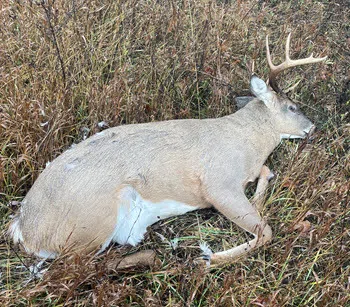It’s tempting to get outside and prune everything in the yard when spring arrives. But if you have an oak tree, please wait. You could save the tree’s life.
From April 15 to July 15, oak trees are at high risk for oak wilt infection, a serious fungal disease that can weaken white oaks and kill red oak trees within a few weeks. During this time of year, flying beetles can carry spores of the fungus from tree to tree. The fungus enters the tree through wounds that are often a result of pruning or storm damage.
“The guidelines against pruning oak trees during this time are designed to help prevent the spread of this tree-killing disease to new areas,” said James Wieferich, forest health specialist in the Michigan Department of Natural Resources’ Forest Resources Division. “Once oak wilt gets started, it is expensive to successfully manage and will kill all nearby red oaks over time, if untreated.”
If you have an oak tree that gets damaged during the high-risk period from April 15 to July 15, immediately cover all wounds with tree-wound paint or latex-based paint. Painting tree wounds is not recommended for other trees species as it can reduce the effectiveness of the healing process.
Oak wilt was first identified in the 1940s and is now widespread across Michigan. Red oaks are most susceptible to the disease. These trees have leaves with pointed tips and include black oak, northern red oak and northern pin oak. Trees in the white oak group have rounded leaf edges and include white oak, swamp white oak and bur oak.
Symptoms most often appear from late June until September. Affected trees will suddenly begin to wilt from the top down, rapidly dropping leaves, which can be green, brown or a combination of both colors.
Once a tree is infected, the fungus also can move to neighboring red oaks through root grafts. Oaks within about 100 feet of each other could have connected, or grafted, root systems. Left untreated, oak wilt will continue to move from tree to tree, killing more red oak over an increasingly larger area. As more trees die from oak wilt, more fungal spores are produced, which allows the beetle to carry infection to new locations.
Firewood cut from infected trees can harbor the fungus, so don’t move firewood from one place in the state to another. If you suspect your firewood is infected by oak wilt, you can help slow the spread by burning it, chipping it or debarking it before April. Once the firewood has been dried for longer than a year and/or all the bark loosens, the firewood can no longer spread oak wilt.
To minimize the risk of oak wilt infection caused by logging damage, the DNR restricts cutting of red oak trees on state land between April 15 and July 15. The DNR recommends private forest landowners exercise caution during this period and, whenever possible, delay harvesting activity in oak forests until after July 15.

























Comments